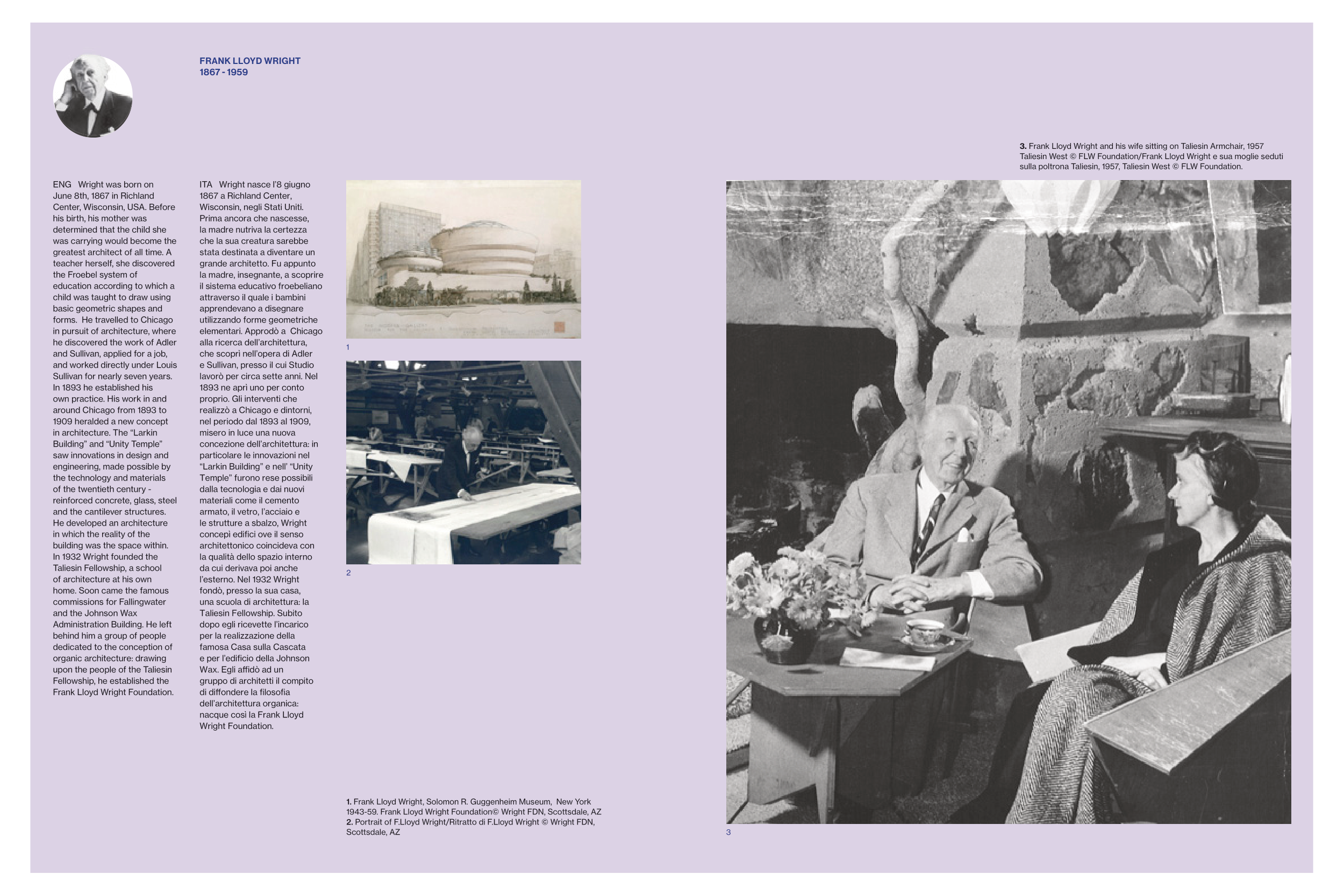FRANK LLOYD WRIGHT
1867 - 1959
1
2
3
ITA Wright nasce l’8 giugno
1867 a Richland Center,
Wisconsin, negli Stati Uniti.
Prima ancora che nascesse,
la madre nutriva la certezza
che la sua creatura sarebbe
stata destinata a diventare un
grande architetto. Fu appunto
la madre, insegnante, a scoprire
il sistema educativo froebeliano
attraverso il quale i bambini
apprendevano a disegnare
utilizzando forme geometriche
elementari. Approdò a Chicago
alla ricerca dell’architettura,
che scoprì nell’opera di Adler
e Sullivan, presso il cui Studio
lavorò per circa sette anni. Nel
1893 ne aprì uno per conto
proprio. Gli interventi che
realizzò a Chicago e dintorni,
nel periodo dal 1893 al 1909,
misero in luce una nuova
concezione dell’architettura: in
particolare le innovazioni nel
“Larkin Building” e nell’ “Unity
Temple” furono rese possibili
dalla tecnologia e dai nuovi
materiali come il cemento
armato, il vetro, l’acciaio e
le strutture a sbalzo, Wright
concepì edifi ci ove il senso
architettonico coincideva con
la qualità dello spazio interno
da cui derivava poi anche
l’esterno. Nel 1932 Wright
fondò, presso la sua casa,
una scuola di architettura: la
Taliesin Fellowship. Subito
dopo egli ricevette l’incarico
per la realizzazione della
famosa Casa sulla Cascata
e per l’edifi cio della Johnson
Wax. Egli affi dò ad un
gruppo di architetti il compito
di diff ondere la fi losofi a
dell’architettura organica:
nacque così la Frank Lloyd
Wright Foundation.
ENG Wright was born on
June 8th, 1867 in Richland
Center, Wisconsin, USA. Before
his birth, his mother was
determined that the child she
was carrying would become the
greatest architect of all time. A
teacher herself, she discovered
the Froebel system of
education according to which a
child was taught to draw using
basic geometric shapes and
forms. He travelled to Chicago
in pursuit of architecture, where
he discovered the work of Adler
and Sullivan, applied for a job,
and worked directly under Louis
Sullivan for nearly seven years.
In 1893 he established his
own practice. His work in and
around Chicago from 1893 to
1909 heralded a new concept
in architecture. The “Larkin
Building” and “Unity Temple”
saw innovations in design and
engineering, made possible by
the technology and materials
of the twentieth century -
reinforced concrete, glass, steel
and the cantilever structures.
He developed an architecture
in which the reality of the
building was the space within.
In 1932 Wright founded the
Taliesin Fellowship, a school
of architecture at his own
home. Soon came the famous
commissions for Fallingwater
and the Johnson Wax
Administration Building. He left
behind him a group of people
dedicated to the conception of
organic architecture: drawing
upon the people of the Taliesin
Fellowship, he established the
Frank Lloyd Wright Foundation.
1. Frank Lloyd Wright, Solomon R. Guggenheim Museum, New York
1943-59. Frank Lloyd Wright Foundation© Wright FDN, Scottsdale, AZ
2. Portrait of F.Lloyd Wright/Ritratto di F.Lloyd Wright © Wright FDN,
Scottsdale, AZ
3. Frank Lloyd Wright and his wife sitting on Taliesin Armchair, 1957
Taliesin West © FLW Foundation/Frank Lloyd Wright e sua moglie seduti
sulla poltrona Taliesin, 1957, Taliesin West © FLW Foundation.


